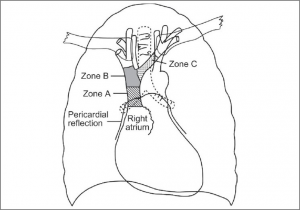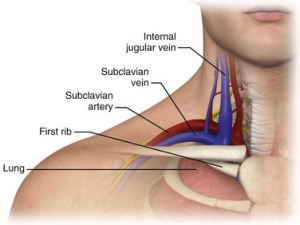All the hard parts are done in the placement of your central line. You nicked the vein and NOT the artery. The wire threaded smoothly. You got confirmation on your ultrasound. Now, you just insert the triple lumen in over the wire. Inserting a central line to the right depth on your first try without needing to adjust after your post-line confirmation chest x-ray takes some practice.
The goal is to get the tip of your catheter in the SVC above the level of the pericardial reflection. You should aim to get the catheter tip lying in the long axis of the SVC without any abutment of the vein. Too deep, and you risk erosion or perforation of surrounding vasculature. You even run the risk of arrhythmia if you go really deep into the heart chambers. Not deep enough, and your line may not effectively deliver meds, and it runs a higher risk of thrombus formation and infection.
The schematic below shows the potential zones for catheter tip positioning. Zone A represents the optimal area for left-sided central lines. At this level, the central line is more likely to lie parallel to the vessel walls. Zone B represents an optimal location for right-sided central lines. Since it’s a straighter shot on the right side, you don’t need to insert as deep to ensure the catheter lies parallel to the vessel wall. Left sided lines should avoid Zone B because the catheter tip has a higher likelihood of irritating the lateral wall of the SVC.

I was looking for a nice diagram indicating the optimal depths for each central line site (RIJ, LIJ, Subclavian, Femoral), but there actually isn’t a great one out there. I realize the reason for this is because patients come in all shapes and sizes. Well, mostly the same shape, but definitely different sizes (see picture below). If you insist on some numbers, a right-sided line can often be somewhere from 15-18. A left-sided line often can be up to 20. Consider whether your patient is a short elderly woman or a tall NBA player. These can vary significantly. Once you do a few with the same CVC kit but a few different sized patients, you get a much better sense of how deep you should be placing them.
For more tips and tricks on getting a great central line placement, check out EMCrit’s central line page.
Sources

